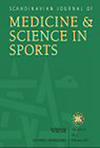Altered Metabolic Activity and Morphology of Lower Limb Muscles 1–2 Years Following Anterior Cruciate Ligament Reconstruction
IF 3.5
2区 医学
Q1 SPORT SCIENCES
引用次数: 0
Abstract
The purpose of this study was to explore between‐limb differences in gluteal, quadriceps, hamstring, and triceps surae muscle size and activity during a repeated vertical jump‐landing task in individuals with a history of unilateral anterior cruciate ligament reconstruction (ACLR). Twelve recreationally active participants with a unilateral history of ACLR involving a semitendinosus autograft (1–2.5 years post‐surgery) underwent functional magnetic resonance imaging (fMRI) before and immediately after 60 vertical jumps. Exercise‐induced increases in transverse (T2) relaxation times and resting muscle volumes were measured in 12 lower limb muscles. Linear mixed models were used to explore differences between the ACLR and uninjured contralateral limb, as well as their relationship with vertical jump performance. Reconstructed limbs displayed smaller muscle volumes in vastus medialis (前交叉韧带重建后1-2年下肢肌肉代谢活动和形态的改变
本研究的目的是探讨具有单侧前交叉韧带重建(ACLR)病史的个体在重复垂直起降任务中臀肌、股四头肌、腘绳肌和三头肌表面肌大小和活动的肢体差异。12名有单侧ACLR(包括自体半腱肌移植)病史的娱乐活动参与者(术后1-2.5年)在60次垂直跳跃之前和之后接受了功能磁共振成像(fMRI)检查。在12块下肢肌肉中测量了运动诱导的横向(T2)松弛时间和静息肌肉体积的增加。采用线性混合模型探讨ACLR与未损伤对侧肢体之间的差异,以及它们与垂直跳跃性能的关系。重建肢体的股内侧肌(p = 0.028)、股直肌(p = 0.019)、半腱肌(p <;0.001),腓肠肌外侧头(p = 0.028)比未受伤的对侧肢体的同名肌肉(p = 0.028)。有ACLR病史的肢体在半腱肌T2松弛时间的百分比变化也较小(p <;0.001)、半膜肌(p = 0.002)、腓肠肌外侧(p = 0.014)和比目鱼肌(p = 0.008),而股外侧肌比未受伤的对侧肢体增加更多(p = 0.001)。股四头肌肌肉体积和活动的肢间不对称与垂直起落脉冲的肢间不对称相关(r2 = 0.30-0.34)。本研究的发现可能有助于设计旨在恢复下肢功能和降低有ACLR病史的个体再损伤风险的运动干预措施。
本文章由计算机程序翻译,如有差异,请以英文原文为准。
求助全文
约1分钟内获得全文
求助全文
来源期刊
CiteScore
7.90
自引率
4.90%
发文量
162
审稿时长
3 months
期刊介绍:
The Scandinavian Journal of Medicine & Science in Sports is a multidisciplinary journal published 12 times per year under the auspices of the Scandinavian Foundation of Medicine and Science in Sports.
It aims to publish high quality and impactful articles in the fields of orthopaedics, rehabilitation and sports medicine, exercise physiology and biochemistry, biomechanics and motor control, health and disease relating to sport, exercise and physical activity, as well as on the social and behavioural aspects of sport and exercise.

 求助内容:
求助内容: 应助结果提醒方式:
应助结果提醒方式:


